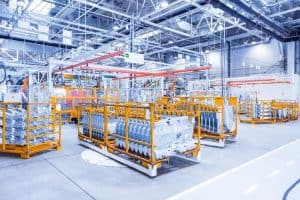Corrosion is an electrochemical reaction. It is therefore not surprising that truck and car batteries often experience extreme corrosion, accelerated by the electrical charge and corrosive acid inside. The resulting powdery grayish greenish buildup on battery terminals can interfere with the battery’s electrical connection to the wires-and potentially keep the vehicle from starting at all. While there is more than one method for cleaning and protecting corroded battery terminals, ElectriCorr™ VpCI®-239 is an easy way to do quick maintenance with a two-in-one product. Here’s how it works!

Dual Cleaning and Corrosion Protection
ElectriCorr™ VpCI®-239 is a multifunctional cleaner/corrosion inhibitor for outdoor or ventilated applications. It may be applied to electrical contacts, wires, and relays. Moisture-displacing, film-penetrating, and corrosion inhibiting characteristics allow it to be used in two main ways:
• Spraying ElectriCorr™ on a dirty surface to easily clean and wipe away grease, grime, and other contaminants.
• Spraying a thin film of ElectriCorr™ on a clean metal surface and leaving it to dry for ongoing corrosion protection.
ElectriCorr™ VpCI®-239 protects both ferrous and non-ferrous metals (e.g., brass contacts) and is safe to use with plastics, elastomers, and other non-metallics.
How to Clean and Protect Battery Terminals with ElectriCorr™
It is always important to wear standard PPE such as safety glasses and gloves when cleaning a battery. For the most thorough cleaning, battery terminals should be disconnected first, following best practices for safety.* Basic cleaning and protection steps are as follows:
1. Spray ElectriCorr™ VpCI®-239 on exposed battery posts as needed to loosen corrosion products and wipe them away with a small brush or disposable cloth.
2. Spray a thin film of ElectriCorr™ VpCI®-239 onto the posts before reconnecting the battery terminals.
3. Reconnect battery terminals according to manufacturer’s safety instructions.
4. Clean corrosion off the outer battery terminals in the same manner as before, spraying ElectriCorr™ VpCI®– 239 as needed to loosen and help remove corrosion products.
5. Spray a final coat of ElectriCorr™ VpCI®-239 on the battery terminals and allow to dry for one to two hours to slow down future corrosion.
Other Places to Use ElectriCorr™
ElectriCorr™ VpCI®-239 can be an invaluable tool at large preservation projects, construction companies, or industrial service providers where fleets of vehicles, heavy equipment, or other battery-powered assets sit outside year-round. In addition to protecting battery terminals, ElectriCorr™ VpCI®-239 is a great cleaner/protector for a variety of other electrical/electronic components.
• Electric motors
• Outdoor generators and junction boxes
• Outdoor and indoor electrical outlets
• Ventilated electrical panels
• Other electrical contacts
Whether you just need to touch up your personal car battery or maintain a parking lot full of company vehicles, ElectriCorr™ VpCI®-239 is one way to quickly and easily clean away the corrosion to promote a good electrical connection and discourage the aggressiveness of corrosion in the future. Contact Cortec® to learn more about this cleaning/protection option for battery terminal corrosion!
Keywords: how to clean corroded battery terminals, how to prevent corrosion on battery terminals, how to prevent corrosion on electrical connections, how to prevent corrosion on a car battery, Cortec, ElectriCorr, electrical corrosion, fleet maintenance, car battery maintenance, car battery won’t start
*Be sure to consult manufacturer’s recommendations for safe handling and removal, which typically involves disconnecting the negative terminal first and reconnecting it last.
Need a High-Resolution Photo? Please Visit: www.cortecadvertising.com
For a PDF version please click here.









